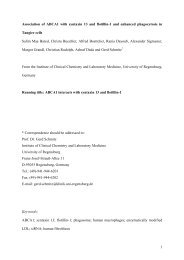SUNDAY, DECEMBER 4- Late Abstracts 1 - Molecular Biology of the ...
SUNDAY, DECEMBER 4- Late Abstracts 1 - Molecular Biology of the ...
SUNDAY, DECEMBER 4- Late Abstracts 1 - Molecular Biology of the ...
Create successful ePaper yourself
Turn your PDF publications into a flip-book with our unique Google optimized e-Paper software.
<strong>SUNDAY</strong><br />
suppressed Akt and Smad1/5 phosphorylation, calcium deposition and Col I α2 mRNA<br />
expression in hADSCs. Most importantly, blockage <strong>of</strong> Akt activation significantly inhibited <strong>the</strong><br />
synergistic enhancement <strong>of</strong> Col I α2 mRNA expression, which was induced by BMP-6 and<br />
VEGF combined treatment.<br />
Conclusion and Discussion:<br />
Our data showed a striking observation that VEGF and BMP-6 synergistically enhanced Col I α2<br />
gene expression in hADSCs. Fur<strong>the</strong>rmore, biochemical blockage <strong>of</strong> Akt activation significantly<br />
inhibited <strong>the</strong> enhancing effects <strong>of</strong> Col I α2 mRNA expression by BMP-6 and VEGF combined<br />
treatment. It is reported that PI3-kinase catalytic is<strong>of</strong>orm is coupled to VEGFR2 and regulates<br />
<strong>the</strong> bulk <strong>of</strong> Akt activity. Moreover, dominant-negative Akt inhibited Smad5 phosphorylation. Our<br />
data and <strong>the</strong>se reported observations toge<strong>the</strong>r establish a novel axis <strong>of</strong> control <strong>of</strong> Col I<br />
expression as VEGF-VEGFR2-PI3K-Akt-Smad1/5-Col I in hADSCs. However, Akt-dependent<br />
BMP-6 modulation <strong>of</strong> this axis remains to be investigated in near future.<br />
2032<br />
A novel gene encoding a candidate CK2 substrate involves in cancer cell proliferation.<br />
H. Yang 1 , S. Liu 1 , H. Zheng 1 , H. Jiang 1 , Y. Qu 1 , Y. Li 1 ; 1 Harbin Institute <strong>of</strong> Technology, Harbin,<br />
China<br />
CK2, a ubiquitous protein serine/threonine kinase, is essential for <strong>the</strong> decision <strong>of</strong> cell survival<br />
and cell death. In <strong>the</strong> present study, we identified a novel gene, Homo Sapiens Chromosome 1<br />
ORF109 which protein product might be a candidate CK2 substrate. The C1ORF109 protein<br />
presented in <strong>the</strong> phosphorylated form in vivo, and could be phosphorylized by <strong>the</strong> protein kinase<br />
CK2 in vitro. Truncated constructs and site direct mutagenesis analysis revealed that Ser104,<br />
Ser 134, and Ser182 were phosphorylated sites. Both TATA box and CAAT box within <strong>the</strong><br />
crucial region <strong>of</strong> c1orf109 promoter are required for maximal transcription <strong>of</strong> <strong>the</strong> c1orf109 gene.<br />
The C1ORF109 protein was mainly located in <strong>the</strong> nucleus and cytoplasm. Upregulated<br />
expression <strong>of</strong> c1orf109 was detected in multiple breast cancer cells. Exogenous expression <strong>of</strong><br />
C1ORF109 in breast cancer Hs578T cells promoted colony formation and cell proliferation<br />
along with increased level <strong>of</strong> PCNA and cyclinD1. Meanwhile, knockdown <strong>of</strong> c1orf109 by siRNA<br />
in breast cancer MDA-MB-231 cells resulted in inhibition <strong>of</strong> cell proliferation. Taken toge<strong>the</strong>r, our<br />
findings suggest that C1ORF109 may be <strong>the</strong> down stream target <strong>of</strong> protein kinase CK2 and<br />
involved in <strong>the</strong> regulation <strong>of</strong> cancer cell proliferation.<br />
Key words: promoter, transcription, CK2 kinase, c1orf109, proliferation<br />
2033<br />
Quantitative detection <strong>of</strong> phosphorylation <strong>of</strong> STAT3 and p38 by Western blotting.<br />
K. Söderquist 1 , S. Grimsby 1 , M. Winkvist 1 ; 1 GE Healthcare, Uppsala, Sweden<br />
Introduction<br />
Western blotting is a well established technique used to study proteins from a wide variety <strong>of</strong><br />
sources. The technique is used throughout life sciences from basic research to medical<br />
diagnostic applications. Western blotting is at best considered as semi-quantitative and hence<br />
limited to studies involving large protein differences. However development <strong>of</strong> detection<br />
reagents as well as imagers has open up for quantitative applications when high sensitivity and<br />
broad dynamic range is needed.<br />
Here we demonstrate how <strong>the</strong> Western blotting technique can be used to determine<br />
phosphorylation levels <strong>of</strong> various proteins in whole cell lysates upon stimulation with various<br />
well known inducers.
















